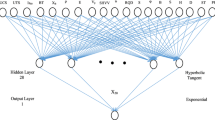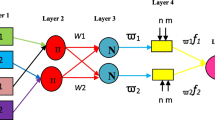Abstract
The paper refers the reader to a blast data base developed in a previous study. The data base consists of blast design parameters, explosive parameters, modulus of elasticity and in situ block size. A hierarchical cluster analysis was used to separate the blast data into two different groups of similarity based on the intact rock stiffness. The group memberships were confirmed by the discriminant analysis. A part of this blast data was used to train a single-hidden layer back propagation neural network model to predict mean particle size resulting from blast fragmentation for each of the obtained similarity groups. The mean particle size was considered to be a function of seven independent parameters. An extensive analysis was performed to estimate the optimum value for the number of units for the hidden layer for each of the obtained similarity groups. The blast data that were not used for training were used to validate the trained neural network models. For the same two similarity groups, multivariate regression models were also developed to predict mean particle size. Capability of the developed neural network models as well as multivariate regression models was determined by comparing predictions with measured mean particle size values and predictions based on one of the most applied fragmentation prediction models appearing in the blasting literature. Prediction capability of the trained neural network models as well as multivariate regression models was found to be strong and better than the existing most applied fragmentation prediction model. Diversity of the blasts data used is one of the most important aspects of the developed models.







Similar content being viewed by others
References
Aler J, Du Mouza J, Arnould M (1996) Measurement of the fragmentation efficiency of rock mass blasting and its mining applications. Int J Rock Mech Min Sci Geomech Abstr 33:125–139
Al-Kaabl AU, Lee WJ (1993) Using artificial neural nets to identify the well-test interpretation model. SPE Form Eval 8:233–240
Ash RL (1973) The influence of geological discontinuities on rock blasting. Ph.D. Thesis, University of Minnesota, 289 p
Castro JT, Liste AV, Gonzalez AS (1998) Blasting index for exploitation of aggregates. In: Singhal RK (ed) Proceedings of the 7th mine planning and equipment selection symposium, Oct, 6–9, 1998, Calgary, pp 165–168
Chakraborty AK, Jethwa JL, Paithankar AG (1994) Effects of joint orientation and rock mass quality on tunnel blasting. Engg Geol 37:247–262
Chakraborty AK, Raina AK, Ramulu M, Choudhury PB, Haldar A, Sahu P, Bandopadhyay C (2004) Parametric study to develop guidelines for blast fragmentation improvement in jointed and massive formations. Engg Geol 73:105–116
Cunningham CVB (1983) The KuzRam model for prediction of fragmentation from blasting. In: Holmberg R, Rustan A (eds) Proceedings of 1st international symposium on rock fragmentation by Blasting, Aug, 22–26, 1983, Lulea, pp 439–453
Cunningham CVB (1987) Fragmentation estimations and KuzRam model–four years on. In: Proceedings of 2nd symposium on rock fragmentation by Blasting, Keystone, Colorado, pp 475–487
Cybenko G (1989) Approximation by superpositions of a sigmoidal function. Math Control Syst Signal 2:303–314
De Groot PFM (1993) Reservoir characterization from 3-D seismic data using artificial neural networks and stochastic modeling techniques. AAPG Bull 77:1617–1618
Draper NR, Smith H Jr (1981) Applied regression analysis, 2nd edn. Wiley, New York, NY
Everitt BS (1993) Cluster analysis. Edward Arnold, London
Everitt BS, Dunn G (1991) Applied multivariate data analysis. Edward Arnold, London
Garson GD (2009) Statnotes: topics in multivariate analysis. http://www2.chass.ncsu.edu/garson/pa765/statnote.htm. 24 Feb 2009
Ge ZX, Sun ZQ (2007) Neural network theory and MATLAB R2007 application. Publishing House of Electronics Industry, Beijing, pp 108–122, 48–50
Ghaboussi J (1992) Potential applications of neuro-biological computational models in Geotechnical engineering. In: Proceedings of the 4th international symposium on numerical models in Geotech, Swansea, UK, pp 543–555
Gheibie S, Aghababaei H, Hoseinie SH, Pourrahimian Y (2009) Modified Kuz–Ram fragmentation model and its use at the Sungun Copper Mine. Int J Rock Mech Min Sci 46:967–973
Ghosh A, Daemen JJK, Vanzyl D (1990) Fractal based approach to determine the effect of discontinuities on blast fragmentation. In: Proceedings of the 31st U.S. symposium on rock mechanics, Balkema, Rotterdam, pp 905–912
Grundstrom C, Kanchibotla S, Jankovic A, Thornton DM (2001) Blast fragmentation for maximizing the SAG mill throughput at Porgera Goldmine. In: Proceedings of the 27th annual conference on explosives and blasting technique, Orlando, Florida, pp 383–399
Hagan TN (1995) The effect of rock properties on the design and results of tunnel blasts. J Rock Mech Tunnel Tech 1(1):25–39
Hall J, Brunton I (2002) Critical comparison of Kruttschnitt Mineral Research Center (JKMRC) blast fragmentation models. Fragblast 6(2):207–220, Swets and Zeitlinger, The Netherlands
Hamdi E, Du Mouza J (2005) A methodology for rock mass characterization and classification to improve blast results. Int J Rock Mech Min Sci 42:177–194
Hecht-Nelson R (1987) Kolmogorov’s mapping neural network existence theorem. In: Proceedings of the 1st IEEE annual international conference on neural networks. IEEE Press, San Diego, Piscataway, NJ, pp III: 11–14
Hjelmberg H (1983) Some ideas on how to improve calculations of the fragment size distribution in bench blasting. In: Proceedings of the 1st ınternational symposium on rock fragmentation by Blasting, Lulea University Technology Lulea, Sweden, pp 469–494
Huberty CJ, Olejnik S (2006) Applied MANOVA and Discriminant Analysis, 2nd edn. Wiley, New Jersey
Hudaverdi T, Kulatilake PHSW, Kuzu C (2011) Prediction of blast fragmentation using multivariate analysis procedures. Int J Num Anal Meth Geomech 35(12):1318–1333
Hustrulid W (1999) Blasting principles for open pit mining. A. A. Balkema, Rotterdam
SPSS Inc (2008) SPSS Base 16.0 User’s Guide
Jhanwar JC, Jethwa JL, Reddy AH (2000) Influence of air-deck blasting on fragmentation in jointed rocks in an open-pit manganese mine. Engg Geol 57:13–29
John FCK, Lim BS, Lennie ENL (1995) Optimal design of neural networks using the Taguchi method. Neurocomputing 225–245
Kanchibotla SS, Valery W, Morrell S (1999) Modeling fines in blast fragmentation and its impact on crushing and grinding. In: Proceedings of the Explo-99 Conference, Kalgoorlie, pp 137–144
Kaufman L, Rousseeuw PJ (1990) Finding groups in data: an introduction to cluster analysis. Wiley-Interscience Publication, Wiley, New York
Kou S, Rustan A (1993) Computerized design and result prediction of bench blasting. In: Proceedings of the 4th international symposium on rock fragmentation by blasting, Vienna, pp 263–271
Kulatilake PHSW, Park J, Balasingam P, Mckenna SA (2007) Hierarchical probabilistic regionalization of volcanism for Sengan Region Japan. Geotech Geol Eng 25(1):79–109
Kulatilake PHSW, Wu Q, Hudaverdi T, Kuzu C (2010) Mean particle size prediction in rock blast fragmentation using neural networks. Eng Geol 114:298–311
Kung TC, Hsiao CL, Schuster M, Juang CH (2007) A neural network approach to estimating excavation-induced wall deflection in soft clays. Comput Geotech 34:385–396
Kuznetsov VM (1973) Mean diameter of fragments formed by blasting rock. Soviet Min Sci 9(2):144–148
Latham JP, Lu P (1999) Development of an assessment system for the blastability of rock masses. Int J Rock Mech Min Sci Geomech Abstr 36:41–55
Latham JP, Kemeny J, Maerz N, Noy M, Schleifer J, Tose S (2003) A blind comparison between results of four image analysis systems using a photo-library of piles of sieved fragments. Fragblast 7(2):105–132
Lee C, Sterling R (1992) Identifying probable failure modes for underground openings using a neural network. Int J Rock Mech Min Sci 29(1):49–67
Li Q, Yu JY, Mu BC, Sun XD (2006) BP neural network prediction of the mechanical properties of porous NiTi shape memory alloy prepared by thermal explosion reaction. Matl Sci Eng 419:214–217
Lilly PA (1986) An empirical method of assessing rock mass blastability. In: Proceedings of the large open pit conference, IMM, Australia, pp 89–92
Maier HR, Dandy GC (1998) The effect of internal parameters and geometry on the performance of back-propagation neural networks: an empirical study. Environ Model Softw 13:193–209
Mckenzie AS (1966) Cost of explosives—do you evaluate it properly? Min Congr J 52(5):32–41
Mojtabai N, Farmer IW, Savely JP (1990) Optimisation of rock fragmentation in bench blasting. In: Proceedings of the 31st US symposium on rock mechanics, Balkema, Rotterdam, pp 897–901
Montgomery DC, Peck EA, Vining GG (2006) Introduction to linear regression analysis. Wiley, New Jersey
Nie SL, Rustan A (1987) Techniques and procedures in analyzing fragmentation after blasting by photographic method. In: Proceedings of the 2nd international symposium on rock fragmentation by Blasting, Keystone, Colorado, pp 36–47
Ouchterlony F, Niklasson B, Abrahamsson S (1990) Fragmentation monitoring of production blasts at Mrica. In: McKenzie C (ed) International symposium on rock fragmentation by Blasting, FragBlast, Aug 26–31, 1990, Brisbane, Australia, pp 283–289
Ozcelik Y (1998) Effect of discontinuities on fragment size distribution in open-pit blasting—a case study. Trans Inst Min Metall Sect A Min Indust 107:146–150
Pal Roy P (1995) Breakage assessment through cluster analysis of joint set orientations of exposed benches of opencast mines. Geotech Geol Eng 13:79–92
Penn BS, Gordon AJ, Wendlandt RF (1993) Using neural networks to locate edges and linear features in satellite images. Comput Geosci 19:1545–1565
Rizzo DM, Doughery DE (1994) Characterization of aquifer properties using artificial neural networks; neural kriging. Water Resour Res 30:483–497
Rogers LL, Dowla FU (1994) Optimization of groundwater remediation using artificial neural networks with parallel solute transport modeling. Water Resour Res 30:457–481
Rogers SJ, Fang JH, Karr CL, Stanley DA (1992) Determination of lithology from well logs using a neural network. AAPG Bull 76:731–739
Rosin P, Rammler E (1933) The laws governing the fineness of powdered coal. J Inst Fuel 7:29–36
Rustan PA (1998) Automatic image processing and analysis of rock fragmentation–comparison of systems and new guidelines for testing the systems. Int J Blast Fragm Fragblast, 15–23, Balkema, Rotterdam
Sanchidrian JA, Segarra P, Lopez LM (2007) Energy components in rock blasting. Int J Rock Mech Min Sci 44:130–147
Schuhmann RJ (1959) Energy input and size distribution in comminution. Trans Am Min Metall AIME Trans 214:22–25
Thomas AL, La Pointe PR (1995) Conductive fracture identification using neural networks. In: Proceedings of the 36th US symposium on rock mechanics, Balkema, Rotterdam, pp 627–632
Tung ATY, Wong FS, Dong W (1994) Prediction of the spatial distribution of the modified Mercalli intensity using neural networks. Earthq Eng Struct Dyn 23:49–62
Yu SW, Zhu KJ, Diao FQ (2008) A dynamic all parameters adaptive BP neural networks model and its application on oil reservoir prediction. Appl Math Comput 195:66–75
Zhang Q, Song JR, Nie XY (1991) The application of neural network to rock mechanics and rock engineering. Int J Rock Mech Min Sci 28:535–540
Zhang L, Luo JH, Yang SY (2009) Forecasting box office revenue of movies with BP neural network. Expert Syst Appl 36:6580–6587
Acknowledgments
This study was partially supported by the Research Fund of the Istanbul Technical University (project name: ‘the investigation of environmentally friendly blast designs for improvement of fragmentation in Istanbul region quarries’). The authors are grateful to the Research Fund of the Istanbul Technical University for their financial support.
Author information
Authors and Affiliations
Corresponding author
Rights and permissions
About this article
Cite this article
Kulatilake, P.H.S.W., Hudaverdi, T. & Wu, Q. New Prediction Models for Mean Particle Size in Rock Blast Fragmentation. Geotech Geol Eng 30, 665–684 (2012). https://doi.org/10.1007/s10706-012-9496-3
Received:
Accepted:
Published:
Issue Date:
DOI: https://doi.org/10.1007/s10706-012-9496-3




